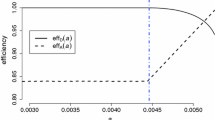Abstract
The calculus of concave functions is a widely accepted tool for optimum experimental design problems. However, as a function of the support points and the weights the design problem fails to be concave. In this paper we make use of generalized gradients in the sense of Rockafellar (1980) and Clarke (1983). A chain rule is presented for the subdifferential of the composition of an information function with the moment matrix mapping. Lipschitz continuity of the global design function is proved and conditions for strict differentiability are given.
Similar content being viewed by others
References
Clarke FH (1983) Optimization and nonsmooth analysis. Wiley, New York
Fellman J (1980) On the behaviour of the optimality criterion in the neighborhood of the optimal point. Swedish School of Economics and Business Administration Helsinki. Working Paper 49
Gaffke N (1985a) Directional derivatives of optimality criteria at singular matrices in convex design theory. Statistics 16: 373–388
Gaffke N (1985b) Singular information matrices, directional derivatives and subgradients in optimal design theory. In Linear Statistical Inference, Proceedings of the International Conference on Linear Inference, Poznań 1984 Caliński T, Klonecki W (Eds). Lecture Notes in Statistics 35, Springer Berlin 61–77
Gaffke N (1987) Further characterizations of design optimality and admissibility for partial parameter estimation in linear regression. Annals of Statistics 15:942–957
Kiefer JC (1974) General equivalence theory for optimum designs (approximate theory). Annals of Statistics 2:849–879
Pukelsheim F (1980) On linear regression designs which maximize information. Journal of Statistical Planning and Inference 4:339–364
Pukelsheim F (1993) Optimal design of experiments. Wiley New York
Rockafellar RT (1970) Convex analysis. Princeton University Press Princeton NJ
Rockafellar RT (1979a) Directionally lipschitzian functions and subdifferential calculus. Proceedings of the London Mathematical Society 39:331–355
Rockafellar RT (1979b) Clarke's tangent cones and the boundaries of closed sets in ℝn. Nonlinear Analysis, Theory, Method & Application 3: 145–154
Rockafellar RT (1980) Generalized directional derivatives and subgradients of nonconvex functions. Canadian Journal of Mathematics 23:257–280
Wilhelm A (1993) Optimale Versuchspläne bei differenzierbaren und nichtdifferenzierbaren Zielfunktionen: Konzepte und Algorithmen. Verlag Shaker Aachen
Wilhelm A (1994) Computing optimal designs by bundle trust methods. Submitted to Statistica Sinica
Author information
Authors and Affiliations
Rights and permissions
About this article
Cite this article
Wilhelm, A. Subdifferentiability and lipschitz continuity in experimental design problems. Metrika 42, 365–377 (1995). https://doi.org/10.1007/BF01894334
Received:
Issue Date:
DOI: https://doi.org/10.1007/BF01894334



